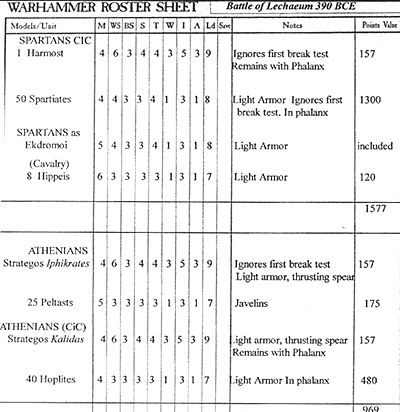The Athenian Strategos Iphikrates' victory over the Spartan mora near Lechaeum, Corinth's port, is hard to recreate as a battle because the numbers are so small. However by using WAB small scale rules, an interesting battle may fought.
Forces:
Lakedaemonians
Mora (Approx. 600 hoplites) 50 figures
Hippeis (Approx. 100 horse) 8 figures
Athenians
Mercenary Peltasts (300) 25 figures
1/2 Taxis (500 hoplites) 40 figures
Victory
The Harmost has to cross the playing field with more than 50% of his forces intact. The Athenians must reduce his force to under 50% before the ninth and final turn. Any other result is a draw.
The Field
The field is 34" long, 16" wide. The road to Lechaeum has the Gulf of Corinth on the Lakedamion player left which he cannot enter. (Hoplites/horse driven into the gulf save on a "6"/ peltasts "5/6") Level ground extends for 15" to his right. After the 15" a range of low hills began which runs the length of the board.
Deployment
The mora starts out in column one move in at the edge of the field. The horse is one move (6") behind the column, off the field. The Athenian peltasts start 10" from the mora's flank The Athenian phalanx starts 30" away from the mora anywhere within 15" area between the water and the low hills. It may be in column or phalanx.Changes to WAB
WAB rules are followed except for the following:
- Oracles /Auspices: Athenian 3 pts. Lakedaemonians 1 pt.
Weapons: Javelin range is reduced to 6"
Movement: Phalanxes start in column. A column is four figures abreast and adds +I to movement. To form phalanx to the front, the unit halts and expands it frontage. It takes Spartiates one turn to do this. It takes the Athenians two turns to do this. A unit caught in column, or changing into phalanx, fights as if it failed its fear check. If the column wishes to form phalanx to the flank it faces 90 degrees to the left or right. It takes the Spartiates ''/z a turn and the Athenians a full turn to do this.
Phalanx Formation: To be in phalanx the unit must be at least four figures deep.
Ekdromoi: Ekdromoi (runners out) was the way Lakedaemon attempted to deal with the peltasts. They are essentially the youngest two classes of hoplites wearing no greaves. Their job was leave the phalanx and chase the peltasts away. Usually if the ekdromoi caught peltasts, they made quick work of them.
Special Rules
1) Between 12-17 figures of hoplites may designated ekdromoi. If all 17 figures are lost, no more are allowed.
2) Ekdromoi move 5". They are mounted as peltasts. If an ekdromoi catches a peltast the peltast fights as if it failed its fear test.
3) Ekdromoi may return to the column or phalanx while it is moving and rejoin as hoplites. They may return if the phalanx is halted. They may not return if the phalanx is engaged in melee.
Athenian hoplites facing Spartiates.
The Athenians were scared of the Spartiates, since they (the Spartiates) had better drill and were tougher. The WAB fear test is replaced with the following:
1) Athenians cannot initiate a charge against the Spartiate phalanx, unless the phalanx is less than 50% of the Athenian numbers (I. E. Athens has 40 figures, the Spartiates 19.) If the charge is in the flank this restriction is waived.
2) The Athenian hoplites may be charged by the Spartiate phalanx. If the number of Spartiates are greater then 50% the Athenians must take a fear test. If 50% or less, the Athenians fight normally.
3.) If the Athenian phalanx is routed, the battle is a draw.

Back to Strategikon Vol. 2 No. 2 Table of Contents
Back to Strategikon List of Issues
Back to MagWeb Master Magazine List
© Copyright 2002 by NMPI
This article appears in MagWeb.com (Magazine Web) on the Internet World Wide Web. Other articles from military history and related magazines are available at http://www.magweb.com